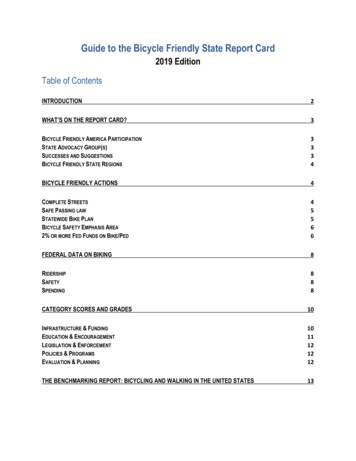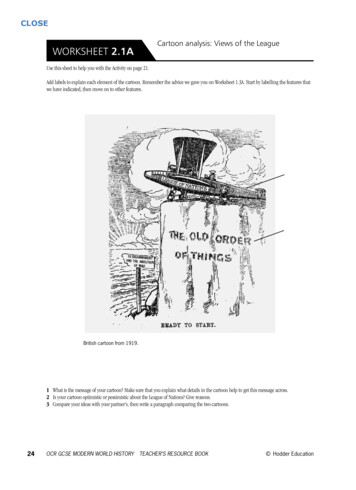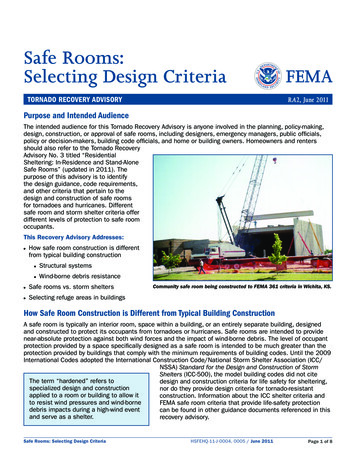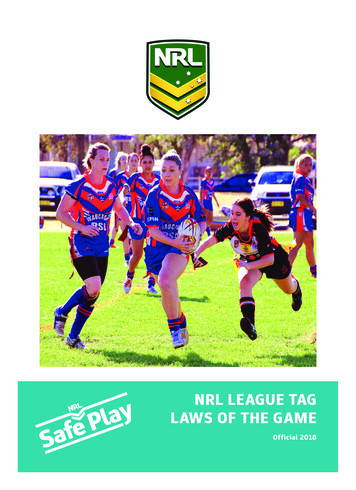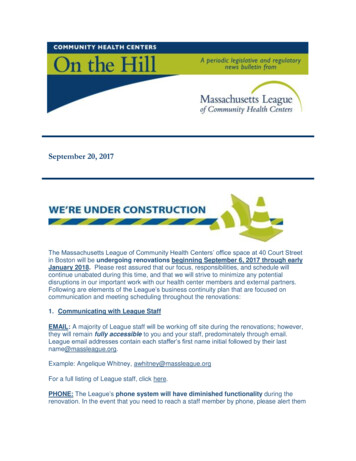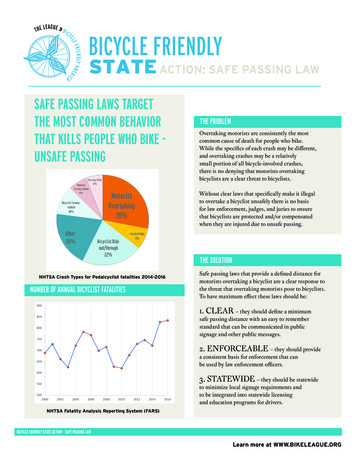
Transcription
ACTION: SAFE PASSING LAWSAFE PASSING LAWS TARGETTHE MOST COMMON BEHAVIORTHAT KILLS PEOPLE WHO BIKE UNSAFE PASSINGTHE PROBLEMOvertaking motorists are consistently the mostcommon cause of death for people who bike.While the specifics of each crash may be different,and overtaking crashes may be a relativelysmall portion of all bicycle-involved crashes,there is no denying that motorists overtakingbicyclists are a clear threat to bicyclists.Without clear laws that specifically make it illegalto overtake a bicyclist unsafely there is no basisfor law enforcement, judges, and juries to ensurethat bicyclists are protected and/or compensatedwhen they are injured due to unsafe passing.THE SOLUTIONNHTSA Crash Types for Pedalcyclist fatalities 2014-2016NUMBER OF ANNUAL BICYCLIST FATALITIES900Safe passing laws that provide a defined distance formotorists overtaking a bicyclist are a clear response tothe threat that overtaking motorists pose to bicyclists.To have maximum effect these laws should be:1. CLEAR – they should define a minimum850safe passing distance with an easy to rememberstandard that can be communicated in publicsignage and other public messages.8007502. ENFORCEABLE – they should provide700a consistent basis for enforcement that canbe used by law enforcement officers.6506003. STATEWIDE – they should be 6to minimize local signage requirements andto be integrated into statewide licensingand education programs for drivers.NHTSA Fatality Analysis Reporting System (FARS)BICYCLE FRIENDLY STATE ACTION - SAFE PASSING LAWLearn more at WWW.BIKELEAGUE.ORG
SAFE PASSING LAWFACTSSee each state’s law at bikeleague.org/bike-law-universityTHE LEAGUE OF AMERICAN BICYCLISTS’ MODEL LAWQUICK FACTSWhen overtaking or passing a person operating a bicycle proceeding in thesame direction, the driver of a motor vehicle shall exercise due care and:A 2014 review of media reports by theLeague of American Bicyclists found that40% of deaths with reported crash typeswere rear-end crashes, likely resulting fromunsafe passing.» If there is more than one lane for traffic proceeding in the samedirection, move the vehicle to the lane to the immediate left, if thelane is available and moving into the lane is reasonably safe; or» If there is only one lane for traffic proceeding in the same direction,pass to the left of the person operating a bicycle at a safe distance, whichmust be not less than 3 feet between any portion of the vehicle and thebicycle, and shall not move again to the right side of the highway untilthe vehicle is safely clear of the overtaken person operating a bicycle.The driver of a motor vehicle may drive to the left of the center of a roadway,including when a no passing zone is marked, to pass a person operatinga bicycle only if the roadway to the left of the center is unobstructed fora sufficient distance to permit the driver to pass the person operating thebicycle safely and avoid interference with oncoming traffic. This paragraphdoes not authorize driving on the left side of the center of the roadway whenprohibited under [the state’s equivalent to UVC sections 11-303 (Overtakinga vehicle on the left), 11-305 (limitations on overtaking on the left), and11-306 (further limitations on driving on left of the center of roadway).]The collision of a motor vehicle with a person operating a bicycleis prima facie evidence of a violation of this section.more at https://bikeleague.org/sites/de»» Learnfault/files/EBC report final.pdf.Data from the Insurance Institute for Highway Safety suggests that 45% of bicyclistdeaths may be due to unsafe passing. Evenwhere no crash occurs, unsafe passing contributes to bicyclist attitudes towards safetyand motor vehicles.more at http://www.iihs.org/iihs/sr/status»» Learnreport/article/50/3/3.According to a 2012 survey by NHTSA, 39%of people who reported a fear for theirpersonal safety said it was due to a motoristdriving very close to them - the most common reason for fear while riding.more at https://one.nhtsa.gov/Driving»» ior.BICYCLE FRIENDLY STATE ACTION - SAFE PASSING LAWLearn more at WWW.BIKELEAGUE.ORG
IMPLEMENTING A SAFEPASSING LAW1. DEVELOP LEGISLATIVE LANGUAGE»» Use the League’s model law or Bike Law Universityresources showing the laws of the 30 states withsafe passing laws.»» Reach out to stakeholders for feedback on yourdraft legislation.»» Respond to stakeholder questions and commentsto ensure support for your legislation.2. PASS A SAFE PASSING LAW»» Find a sponsor.»» Introduce a bill into one or more legislativechambers.»» Advance the bill through the appropriatecommittee(s).»» Pass the bill in both chambers.»» Have Governor sign the bill.League provides model»» Thelegislative language as a template.3. EDUCATE LAW ENFORCEMENT,PROSECUTORS, AND JUDGES ABOUT THENEW LAW»» Law enforcement should be educated regardinghow and when to cite the law, potential proactive or high visibility education and enforcementcampaigns, and how to use the law in the event ofa crash.»» Prosecutors should be educated regarding the existence of the law, how to prosecute the law – including how to prove a passing distance, and howthe law fits into other charging options – such asvehicular manslaughter.»» Judges should be educated regarding the existence of the law, the standard of proof needed tosatisfy the law, and how to instruct juries aboutthe law.2016, Pennsylvania passed the»» InDavid(Dave) Bachman Act, inmemory of a PennDOT’s first Bicycle/Pedestrian Coordinator, which createda license plate that identifies their 4foot passing law. Proceeds from theplate fund bicycle safety efforts.BICYCLE FRIENDLY STATE ACTION - SAFE PASSING LAWLearn more at WWW.BIKELEAGUE.ORG
nal bicyclists, including bicycleclubs, often ride where there are not bicyclefacilities. A safe passing law can helppromote safety and awareness of bicyclistson those roads.PARENTSParents are often concerned about thesafety of their children while bicycling.While a safe passing law is not a substitutefor proper bicycle infrastructure, it is areassuring sign that the state believes in theimportance of bicycle safety.LAW ENFORCEMENT Law enforcement will ultimately beresponsible for enforcing and issuingcitations under an adopted safe passinglaw. Law enforcement should be consultedearly in the process of pursuing a safepassing law so that the adopted law isone they are comfortable and confidentenforcing.GOVERNOR’SHIGHWAY SAFETYOFFICEGovernor’s Highway Safety Offices areresponsible for public education on trafficsafety issues. They can be great allies inraising public awareness of a safe passinglaw. To learn more see “A Right to theRoad” published by the GHSA.BICYCLE FRIENDLY STATE ACTION - SAFE PASSING LAWLearn more at WWW.BIKELEAGUE.ORG
IMPLEMENTING A SAFEPASSING LAW4. EDUCATE STATE, COUNTY, AND LOCALTRANSPORTATION ENGINEERS ANDDEPARTMENTS ABOUT THE NEW LAW»» Guidance from the Manual on UniformTraffic Control Devices (MUTCD) states:This signage combines two MUTCD-compliantsigns to convey the message that motoristsmust change lanes to pass a person on a bike»» The Bicycle May Use Full Lane»»Sign (BMUFL) is found in theMUTCD as sign R4-11“Change Lanes to Pass” is nota specific sign, but is allowedunder MUTCD Section 2B.02“Special word message signs for the three-foot law shouldnot be installed haphazardly and should be limited tolocations where the operation of the two vehicle typesis demonstrating a problem or crash history. Thus,installing these signs where say a physically-separatedbikeway exists would be counterproductive to achievingthe agency’s goal. An example of a special word-onlymessage sign for this application could be a four-lineblack on white regulatory sign with the legendCHANGE :: LANES :: TO PASS :: BICYCLES.”»» Several states have adopted safe passing-related signsinto their state MUTCD. The signs adopted byFlorida, Utah, and California have been evaluatedfor inclusion in the national MUTCD and mayprovide a good model for your state. Please consultthe Bicycle Technical Committee of the NationalCommittee on Uniform Traffic Control Devicesif you have questions about appropriate signage.»» Education should focus on how the safe passingsign is from the California MUTCD.»» ThisIt is referred to as sign R-117.law complements bicycle infrastructure,when regulatory signage may be appropriate,and potential changes to the right ofway that may facilitate safe passing.»» Many safe passing laws have limitedexceptions to no-passing zones andsignage may be appropriate to make driversaware of those limited exceptions.»» It may be appropriate to alter lane widths,shoulder widths, or other roadwaycharacteristics to facilitate safe passing.»» Bicycle infrastructure is generally preferableto regulatory signs notifying driversof their duties towards bicyclists.BICYCLE FRIENDLY STATE ACTION - SAFE PASSING LAWLearn more at WWW.BIKELEAGUE.ORG
RECENT CAMPAIGNOHIO BICYCLE FEDERATIONIn 2016, the Ohio legislature passed, and the Governor signed a safe passing law for Ohio. This success came after years of hard work by the Ohio Bicycle Federa-tion and other League of American Bicyclists’ member organizations including Bike MiamiValley, Bike Cleveland, Queen City Bike, and other advocacy organizations and clubs throughout Ohio.The campaign for a safe passing law began in earnest in 2009 when the Ohio Bicycle Federation worked with state senator Teresa Fedor (D) from Toledo, Ohio to introduce a bill in theSenate Transportation Committee. The bill was introduced with a news conference at the endof a bike ride from her home district to the state capitol in Columbus (160 miles). Althoughthat bill did not get a vote in the committee it set the stage for future efforts.The Ohio Bicycle Federation continued to work on building support for a safe passing lawover the years. The next step was an introduced bill in the state House of Representatives,this time by state representative Mike Henne (R) in 2011. Multiple bills followed over thenext several years until HB 154 was introduced into the House of Representatives in 2015 – atwhich point the Ohio Bicycle Federation and other bicycle advocacy organizations and clubsbegan a phone and email campaign focused on the Ohio Speaker of the House to ensure thatthe bill came up for a vote. Phone calls were especially effective in moving the bill forward.2009Bill firstintroducedin Senate2011Bill firstintroducedin House2012 - Multiple2016billsOhio’s safe passing law was adopted with broad bi-partisan support. The final bill had 42co-sponsors and bi-partisan primary sponsors in Rep. Henne (R) and Rep. Sheehy (D). Itwas passed 30-1 in the Senate and 89-4 in the House and signed into law on December19th, 2016 by Governor Kasich (R). It became law in March 2017 and the Ohio Bicycle Federation has been educating the public and law enforcement on the law since that time.The League’s most recent Bicycle Friendly State report card indicates thatOhio lacks two other Bicycle Friendly Actions:1. a Complete Streets law or policy, and2. a Statewide Bicycle Master Plan adopted within the last 10 ICYCLE FRIENDLY STATE ACTION - SAFE PASSING LAWLearn more at WWW.BIKELEAGUE.ORG
IMPLEMENTING A SAFEPASSING LAW5. ENFORCE THE LAW»» The C3FT device manufactured by Codaxus hasbeen designed to be used by law enforcementand municipalities to accurately measure thedistance between a passing vehicle and a bicycleequipped with the C3FT device. This allowslaw enforcement officers to provide easy tounderstand evidence to drivers, prosecutors,and judges regarding unsafe passing.»» Video camera equipped bicyclists can use theirvideos as evidence in law enforcement actionsor tort cases related to an injury they suffered.In some states, the use of video evidence for lawenforcement may be limited as either the law orstandard law enforcement practices require thatan officer observes the traffic violation in person.You should ask your local law enforcement agencywhether citations or warnings can be issued basedupon video evidence and what law, regulation,or adopted practice limits its consideration.evidence collected by citizens has»» Videobeen used to charge drivers in somejurisdictions. Cyclistvideoevidence.comhas spearheaded some of those efforts.6. USE THE LAW AS A GUIDE FORPLANNING ACTIVITIES»» For municipal employees, data from the C3FTdevice may be useful in infrastructure planning tosee where bicyclists may be more likely to experienceunsafe passing.»» A safe passing law is not a replacement oralternative to proper bicycle infrastructure,and the passage of a safe passing law shouldbe a signal of the government’s intent to makebicycling safer. Buffered or separated bicycle lanesmay be effective at ensuring that bicyclists inbicycle lanes are given a safe passing distance.C3FT device by Codaxus»» Theprovides a means for accuratelymeasuring passing distance forlaw enforcement and planners.BICYCLE FRIENDLY STATE ACTION - SAFE PASSING LAWLearn more at WWW.BIKELEAGUE.ORG
CURRENT CAMPAIGNNEW JERSEY BIKE & WALK COALITIONThe New Jersey Bike & Walk Coalition (NJBWC) began campaigning fora safe passing law in 2009. Bicycle and pedestrian safety was a chief motivation for thecreation of NJBWC as 30% of traffic fatalities in New Jersey are people who bike and walk.Despite the pressing need to address bicyclist and pedestrian safety through better laws andenforcement, the story of New Jersey’s safe passing law campaign highlights coalition buildingin response to legislator demands that are not related to safety.2009 1st billintroducedUpon introduction of the 2009 bill, legislators in the state Senate asked for advocatesto meet two hurdles before they would schedule a vote: 1) get the law endorsed by thestate’s Attorney General, and 2) get the law endorsed by the state Department of Transportation.In 2014, NJBWC returned with a significantly revised bill based upon the state’s existing“Move Over” law which requires motorists to change lanes for law enforcement and emergency personnel working on the side of a roadway. Every state currently has a “Move Over” lawfor law enforcement and other roadside workers. The bill introduced in 2014 was significantlybroader than bicyclists, including safe passing of many vulnerable road users – in response toNew Jersey’s high proportion of traffic fatalities who are people outside of cars.Throughout 2014, the bill gained momentum including satisfying the hurdles put in placein 2009 with both the state’s Attorney General and state DOT supporting the bill. Together,NJBWC, working with the Tri-State Transportation Campaign, gained the support of manygroups, including:»» AAA, through its regional clubs that include New Jersey.»» AARP, whose Livable Communities program supports the efforts of neighborhoods,towns, cities and rural areas to be great places for people of all ages.»» Bicycle Coalition of Greater Philadelphia, a League of American Bicyclists’ memberorganization which includes areas in south New Jersey such as Camden and Trenton;and»» New Jersey Police Traffic Officers Association, who helped NJBWC tailor its legislativelanguage to address law enforcement concerns.After garnering broad support and building a coalition responsive to initial legislator demands, the bill stalled because a legislator who said his constituents do not want bicycleson the road was in a position to prevent a vote. While New Jersey has not yet passed a safepassing law, the coalition built by NJBWC has set the stage for future success.The League’s most recent Bicycle Friendly State report card reiterates oursupport for a safe passing law in New Jersey and highlights it as one of twoBicycle Friendly Actions that New Jersey has not yet taken.2014 Broader“MoveOver”Bill2015BillStalled2018 ReadyforActionBICYCLE FRIENDLY STATE ACTION - SAFE PASSING LAWLearn more at WWW.BIKELEAGUE.ORG
RESOURCESMODEL LAWThe League of American Bicyclists created a model safe passinglaw in 2015. It is available here: aw-0CITATIONS FOR STATELAWSThe League of American Bicyclists’ review of state safe passinglaws, including citations to each state’s law: UTGERS UNIVERSITYREPORT ON SAFEPASSING LAWSReport by Rutgers University about the experience of state’s thathave passed 3 foot passing laws, primarily based upon interviewswith advocates and state officials: oot-Final-Report-Draft V7.pdfUSE OF SAFE PASSINGLAW IN A CRASHLocal example of 3 foot law enforcement from the Washingtonarea Bicyclist Association: orm/POLICE USE OF C3FTDEVICEExample of technological approach to 3 foot passing lawenforcement: ice-enforce-state-3-foot-lawNational Conference of State Legislatures’ review of currentNCSL REPORT ON SAFE Thesafe passing laws: G LAWSsafely-passing-bicyclists.aspx“FALLOVER DISTANCE”ALTERNATIVE TO 3FOOT STANDARDRay Thomas’ explanation of the fall over distance standard as analternative to the 3 foot or “safe distance” standard: https://www.youtube.com/watch?v HHmToEN4LL8CALIFORNIA MUTCDSIGN GUIDANCEThe California MUTCD’s 3 foot passing sign is one option pursuedby the NCUTCD for nationwide adoption: TCD2014-Part9.pdfCHANGE LANES TOPASS GUIDANCEThe City of Boston applied to the FHWA for an experimentalapproval of using “Bicycles May Use Full Lane” in conjunctionwith Change Lanes to Pass signage: https://mutcd.fhwa.dot.gov/documents/pdf/9 09 24 city req ltr.pdfCHANGE LANES TOPASS EXAMPLEThe City of Columbus, Ohio uses BMUFL and Change Lanesto Pass signage: LE FRIENDLY STATE ACTION - SAFE PASSING LAWLearn more at WWW.BIKELEAGUE.ORG
BICYCLE FRIENDLY STATE ACTION - SAFE PASSING LAW QUICK FACTS When overtaking or passing a person operating a bicycle proceeding in the same direction, the driver of a motor vehicle shall exercise due care and: » If there is more than one lane for traffic proceeding in the same direction, move the vehicle to the lane to the immediate left, if the

